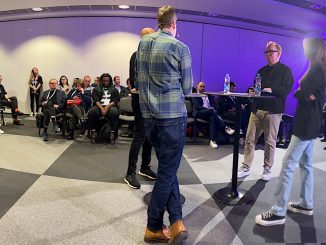FCC Actions
Ted Austin’s Snake River Radio has won its license renewal hearing for 1490 KPCQ Chubbock/Pocatello ID with the FCC’s Administrative Law Judge Jane Hinckley Halprin.
The FCC designated the station for a hearing in February 2022 to determine whether to proceed with its pending license renewal due to its limited operational status since acquiring the station in 2018 and questions of whether the license should be considered expired automatically due to extended periods of silence.
Judge Hinckley Halprin has granted KPCQ a limited one-year license renewal writing, “Snake River Radio has proved by a preponderance of the evidence that the station was not off the air for more than 12 consecutive months.” She follows, “Snake River Radio has not proved by a preponderance of the evidence that it satisfied the renewal standards of section 309(k)(1), but that mitigating factors exist to find that a one-year renewal of the station’s license pursuant to section 309(k)(2) is in the public interest and constitutes an appropriate sanction.”
The FCC has rejected Media Power Group, Inc’s Petition for Reconsideration for the deletion of 100.5 W236DS Juncos and 105.3 W287DP Dorado PR.
Media Power Group was granted the Construction Permits for the translators in November 2018 and a few days before they were to expire, Media Power Group sought tolling to extend the period due to the COVID-19 pandemic and hurricanes. During that period, the FCC was working remotely and had issued a notice stating that all tolling requests were to be emailed to a certain FCC attorney for processing, however Media Power Group’s requests were sent to a member of the agency’s engineering staff and not granted. As soon as W287DP’s CP expired, Wilfredo Blanco-Pi applied to move 92.1 W221EL Barceloneta-Manati PR to 105.3. After discussion with the FCC’s senior deputy chief, amendments were filed to the tolling applications a couple weeks later in which MPG indicated that it had never been able to obtain access to the permitted sites for either station prior to the construction deadline; had built temporary facilities for W236DS at an undisclosed location with an other-than-authorized antenna; subsequently dismantled the temporary facilities while looking for a different site; and was negotiating a site lease for W287DP claiming that use of a local government site was delayed because the government had prioritized hurricane response and that equipment delivery was taking much longer than it had pre-COVID.
The FCC ruled that because MPG submitted the tolling requests to the wrong person, they were never properly submitted, but even if they had the primary reason that they did not construct is that it had no lease and/or local permits for the authorized sites it chose nor could the delays affect construction because they never timely ordered equipment.
The FCC has also rejected Michael Lueck’s Petition For Reconsideration for the restoration of the surrendered license of Kalamazoo Broadcasting Company’s 1440 WKPR Kalamazoo MI.
Lueck filed his petition in February following the January surrender of WKPR’s license claiming that the surrender of the Station’s license is invalid because it was signed by KBC’s attorney without a certification from KBC, WKPR should have included its reasons for discontinuing operations, and WKPR should have given listeners notice of its intent to discontinue operation, to afford opportunity for assignment of the license. The FCC states that Lueck cited no rules about the surrender being invalid or needing to have included its reasons and that they cannot require KBC to resume broadcasting nor can it require them to seek out and enter into an agreement with another party to assign the station.
Salem State College Board of Trustees’ 91.7 WMWM Salem MA has entered a consent decree and agreed to a $500 fine for failing to timely file its license renewal application. WMWM’s license renewal application was due to be filed by December 1, 2021 before its expiration on April 1, 2022. WMWM did not file until May 1, 2022.
Deletions
After taking “Good Time Oldies 107.5” 790 KOSY/107.5 K298DB Texarkana AR last September following the failure of its transmitter, Townsquare Media has turned in the licenses.
Martins & Associates has requested the cancellation of 1000 WKVG Jenkins KY
After failing to respond to an FCC inquiry on the status of the station, Faith Please God Church Corp.’s 90.7 KTER Rudolph TX has been deleted as the FCC noted their records indicated the station had been off the air since May 2021.
Silent Notifications
Petracom of Holbrook’s 93.5 KZUZ Show Low AZ (Transmitter replacement)
Sonora Sierra Heritage Foundation’s 107.5 KJCN Sutter Creek CA (Flooding)
Louisiana Tech University’s 89.1 KLPI Ruston LA (Transmitter replacement)
WBOC Inc’s 1240 WCEM Cambridge MD (Technical issues)
AM Changes
Davidzon Radio’s Brokered Ethnic 620 WSNR Jersey City NJ/New York proposes […]






